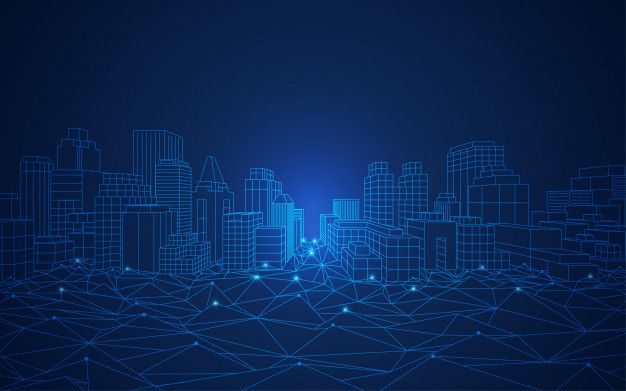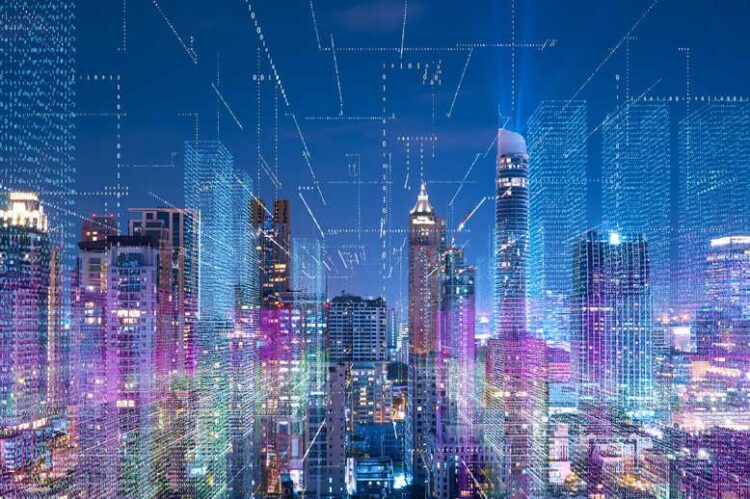Our cities are the beating hearts of modern civilization, centers of commerce, culture, and human connection. But as the world’s population becomes increasingly urbanized, these metropolises face a monumental challenge: how to manage growth, improve efficiency, and enhance the quality of life for millions of residents without overwhelming existing resources. The answer lies not in more concrete and steel, but in a new kind of urban fabric woven from data, technology, and connectivity. Welcome to the era of smart cities, urban centers that leverage digital infrastructure to solve complex problems and create a more sustainable, livable, and responsive environment. This article will take a deep dive into the core technologies that enable smart cities, explore the tangible benefits they deliver to citizens and governments, and critically examine the ethical and practical challenges that must be addressed to ensure a truly inclusive and secure future.
The concept of a smart city is simple in theory but revolutionary in practice. It’s about using technology to collect and analyze real-time data to make better, more informed decisions about everything from traffic flow and energy consumption to public safety and waste management. This isn’t just about adding Wi-Fi hotspots to a park; it’s about building a nervous system for the city—a network of interconnected devices and sensors that can “feel” the pulse of urban life and respond dynamically. The goal is to move beyond reactive city management to a proactive model, where problems are anticipated and solved before they even arise. The transition to a smart city is not a single project, but a continuous journey of innovation, collaboration, and strategic investment in the digital underpinnings of urban life.
A. The Pillars of Smart City Digital Infrastructure
A smart city is not a single technology but a complex ecosystem of interconnected systems. The seamless integration of these technological pillars is what makes the entire system function.
A. The Internet of Things (IoT): The IoT is the foundational layer of any smart city. It consists of a vast network of sensors, devices, and machines embedded throughout the urban landscape that collect and transmit data in real time. These sensors are the “eyes and ears” of the city, providing a continuous stream of information that can be used to optimize services.
- Smart Transportation: IoT sensors are installed in roads, bridges, and traffic lights to monitor traffic density and flow. This data is used to dynamically adjust traffic signals, reroute vehicles to reduce congestion, and provide real-time updates to citizens on their commutes.
- Smart Waste Management: Sensors placed in garbage bins can alert sanitation departments when a bin is full, allowing them to optimize collection routes and save fuel, time, and labor. This not only reduces costs but also improves sanitation and cleanliness.
- Smart Utilities: IoT devices can monitor energy and water consumption in real time, identifying leaks and inefficiencies. This data allows utility companies to manage resources more effectively and helps residents reduce their consumption, leading to significant savings and a smaller environmental footprint.
B. High-Speed Connectivity Networks (5G, Fiber Optics): The massive amount of data collected by IoT sensors would be useless without a fast, reliable network to transmit it. The deployment of advanced connectivity networks is therefore a critical enabler of smart city applications.
- 5G Technology: The new generation of cellular technology, 5G, is a game-changer for smart cities. Its high speeds, low latency, and ability to connect a vast number of devices simultaneously are essential for applications like autonomous vehicles, where real-time data transfer is a matter of life and death.
- Fiber Optic Networks: Fiber optic cables provide a high-bandwidth backbone for city-wide data transmission. They are crucial for connecting data centers, public safety systems, and other critical infrastructure that requires an ultra-fast and reliable connection. This network is the digital highway that all smart city services rely on.

C. Data Analytics and Artificial Intelligence (AI) Platforms: Raw data from IoT sensors is just a jumble of numbers. To make it useful, it must be processed and analyzed. This is where AI and machine learning come in. These powerful tools are the “brain” of the smart city, making sense of the data and using it to make intelligent decisions.
- Predictive Analytics: AI algorithms can analyze historical and real-time data to predict future events. For example, a city might use AI to predict traffic congestion before it happens, allowing them to proactively adjust traffic lights. Or they could use AI to identify patterns in crime data to allocate police resources more effectively.
- Automated Resource Management: AI can be used to manage complex systems like a city’s power grid. A smart grid, for instance, uses AI to predict energy demand and automatically adjust supply, preventing blackouts and reducing waste. Similarly, AI can manage a city’s water supply, detecting leaks and optimizing water distribution.
D. Cloud Computing and Data Management: All the data collected from a smart city needs to be stored, managed, and processed. Cloud computing provides a scalable, secure, and cost-effective solution for this.
- Scalability: As a city grows and adds more sensors and services, its data needs will grow exponentially. The cloud can scale up or down as needed, providing a flexible infrastructure that can handle fluctuating data loads without a massive upfront investment in physical hardware.
- Data Security and Management: Cloud providers offer advanced security features and data management tools that are crucial for protecting sensitive city data from cyberattacks. This centralized management also ensures that data is accessible to all relevant city departments in a secure and controlled manner.
B. The Tangible Benefits of Smart Cities
The integration of digital infrastructure is not merely about technology for technology’s sake. It delivers real-world benefits that improve the lives of residents and the efficiency of city operations.
A. Enhanced Mobility and Transportation: Smart cities are designed to get people and goods where they need to go faster and more safely. By using real-time data to optimize traffic flow, smart cities can reduce congestion, lower fuel consumption, and decrease air pollution. In the future, this infrastructure will also be essential for the widespread adoption of autonomous vehicles, which will communicate with the city’s network to navigate streets and avoid accidents. Smart public transportation systems can also use data to provide accurate arrival times and adjust service based on demand, making public transit a more attractive option.
B. Greater Environmental Sustainability: Smart cities are inherently more sustainable. By using IoT sensors and AI to manage resources, they can significantly reduce waste and energy consumption. Smart grids can optimize energy use, while smart streetlights can dim or turn off when no one is around. Smart waste management systems ensure that garbage is collected only when bins are full, reducing fuel consumption and emissions. Real-time air quality monitoring systems can also provide data that helps cities take action to reduce pollution and improve public health.
C. Improved Public Services and Citizen Engagement: Smart cities leverage technology to make public services more accessible and responsive. Digital platforms and mobile apps can allow citizens to report issues like potholes or broken streetlights, track the status of city services, and get real-time emergency alerts. This direct communication empowers citizens and builds trust with government. Telemedicine and digital health services can also be integrated into a smart city’s infrastructure, improving healthcare access, especially for the elderly or those in remote areas.
D. Increased Public Safety and Security: Smart cities use technology to create a safer environment for residents. Smart surveillance cameras with AI-powered analytics can detect suspicious activity or help first responders identify people in a crowd during an emergency. Drones and other connected devices can be used to quickly assess a disaster area or help locate a missing person. By analyzing data on crime hotspots and traffic accidents, city officials can make more informed decisions about resource allocation to prevent future incidents.
C. The Challenges and Ethical Considerations
While the vision of a smart city is compelling, its realization is fraught with significant challenges that must be addressed carefully to avoid creating a dystopian reality.

A. Data Privacy and Surveillance: The most significant ethical challenge is the tension between data collection and individual privacy. A smart city’s effectiveness is directly tied to the amount of data it collects on its citizens. This raises serious concerns about government surveillance, the potential for data misuse, and the risk of a person’s movements and activities being tracked without their consent. Regulations like the GDPR and CCPA are crucial, but a broader public discussion about the acceptable limits of data collection is necessary.
B. Cybersecurity and Infrastructure Vulnerability: A smart city’s reliance on a single, interconnected digital infrastructure makes it a prime target for cyberattacks. A successful attack could cripple essential services, from the power grid and water supply to transportation and emergency services. This vulnerability makes robust cybersecurity a non-negotiable requirement. Cities must invest in advanced security protocols, regular audits, and incident response plans to protect against threats from hackers and malicious state actors.
C. Digital Inclusion and the Urban Divide: The benefits of a smart city will only reach a small fraction of the population if large segments lack access to the necessary technology. The digital divide can be exacerbated if smart city services are built on a foundation that excludes low-income residents or those without reliable internet access. To be truly smart, a city must be inclusive, ensuring that all citizens have equal opportunities to benefit from urban innovation, whether through public Wi-Fi programs, digital literacy initiatives, or affordable access to technology.
D. High Implementation Costs: The financial investment required to build a smart city’s digital infrastructure is substantial. The cost of deploying a city-wide fiber network, installing thousands of IoT sensors, and developing the necessary software platforms can run into the billions of dollars. This high barrier to entry can prevent many cities, particularly in developing nations, from adopting these technologies, leading to a new kind of global inequality.
In conclusion, the evolution of smart cities is not just a technological trend; it’s a fundamental re-imagining of urban life. By strategically integrating a robust digital infrastructure, cities can become more efficient, sustainable, and responsive to the needs of their residents. However, the path forward requires more than just innovation. It demands a thoughtful approach to data privacy, a steadfast commitment to cybersecurity, and a focus on ensuring that the benefits of this digital transformation are shared by everyone. The future of our cities is bright, but only if we build them not just to be smart, but also to be fair, inclusive, and secure.












